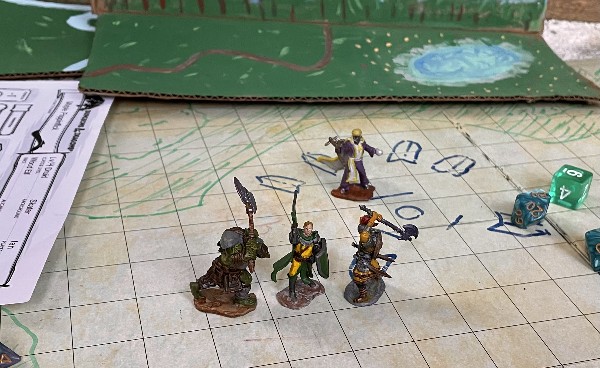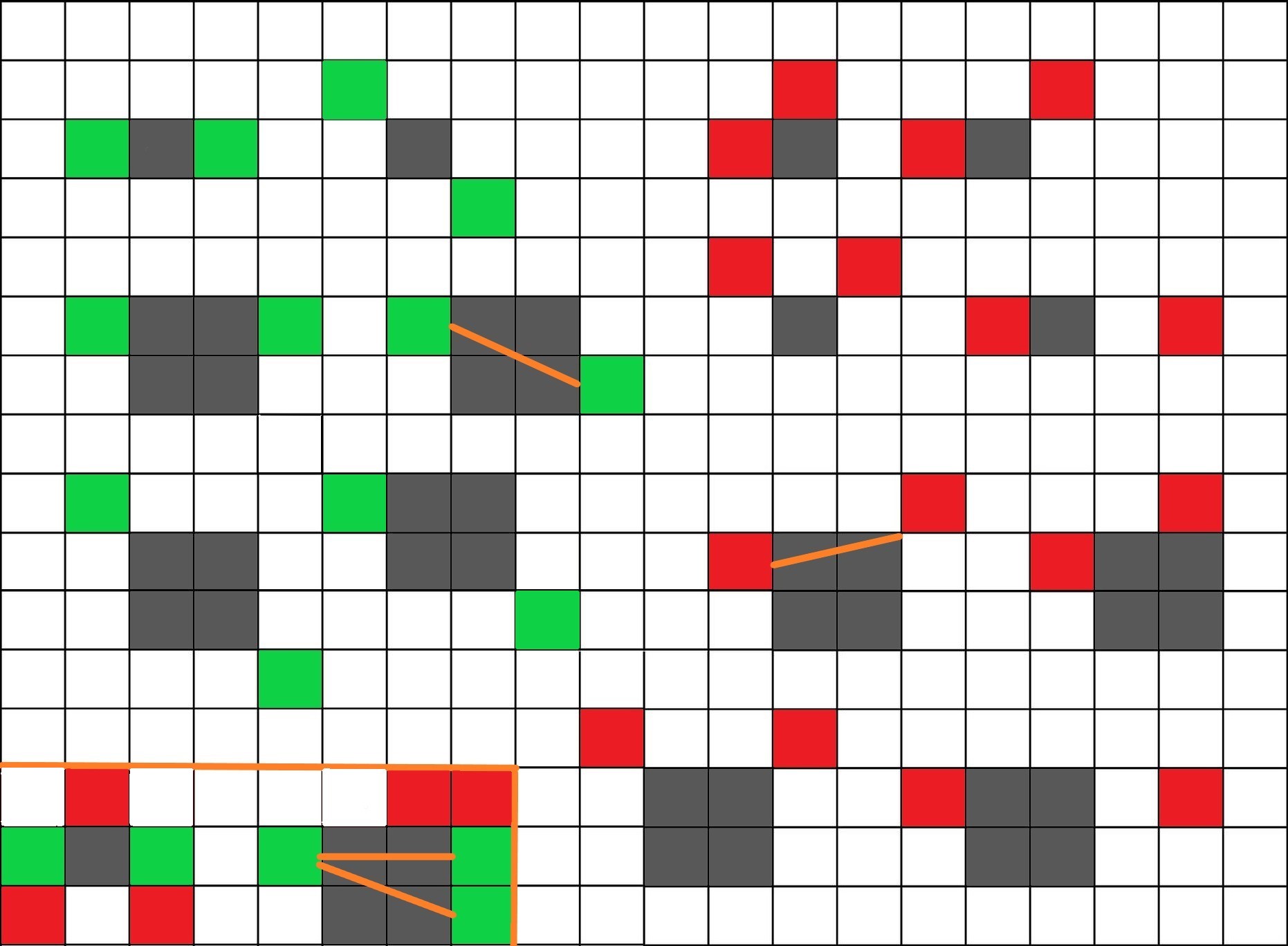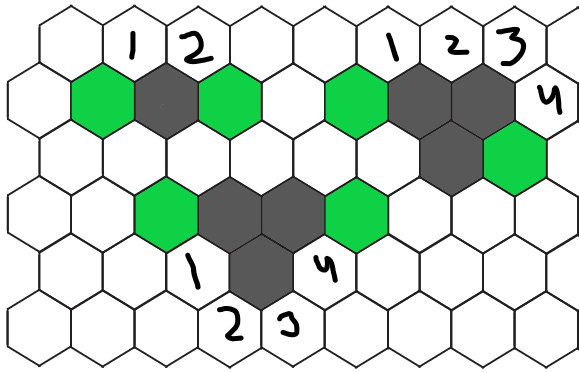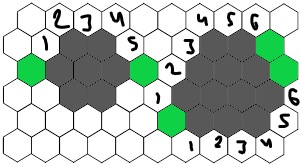A creature can’t flank an enemy that it can’t see. A creature also can’t flank while it is incapacitated. A Large or larger creature is flanking as long as at least one square or hex of its space qualifies for flanking.
Flanking on Squares. When a creature and at least one of its allies are adjacent to an enemy and on opposite sides or corners of the enemy’s space, they flank that enemy, and each of them has advantage on melee attack rolls against that enemy.
When in doubt about whether two creatures flank an enemy on a grid, trace an imaginary line between the centers of the creatures’ spaces. If the line passes
through opposite sides or corners of the enemy’s space, the enemy is flanked.
Flanking on Hexes. When a creature and at least one of its allies are adjacent to an enemy and on opposite sides of the enemy’s space, they flank that enemy, and each of them has advantage on attack rolls against that enemy. On hexes, count around the enemy from one creature to its ally. Against a Medium or smaller creature, the allies flank if there are 2 hexes between them. Against a Large creature, the allies flank if there are 4 hexes between them. Against a Huge creature, they must have 5 hexes between them. Against a Gargantuan creature, they must have at least 6 hexes between them.
Dungeon Master’s Guide, pg. 251
Flanking 5e
Flanking is an optional rule in DnD 5e that many dungeon masters choose to tweak or ignore entirely. There’s a common feeling among players and DMs alike that flanking makes advantage far too ubiquitous in combat, as well as leading to some unrealistic battle formations.
We’ll go over the rules-as-written, as well as popular DM adaptations of the flanking rule. We’ll also get into more detail about who benefits the most from flanking and why exactly the standard rules annoy so many people.
How Does Flanking Work in 5e?
Flanking is a mechanic in DnD that’s based on the real-world battle tactic of surrounding your enemies to gain an advantage in combat. Flanking in DnD 5e works (more or less) intuitively — if two allies are adjacent to and on opposite sides of an enemy, that enemy is flanked.
As a result, those two allies both have advantage on attack rolls against that enemy.
Flanking only really works if you’re using two things: battle maps and miniatures. Without those two visual representations, you’ll find it very difficult (if not impossible) to track flanking bonuses by using theater of the mind alone.
The rules for flanking vary slightly depending on whether your map uses a square or hexagon grid system. While you may think that square grids make flanking simpler, the opposite is actually true.
Let’s cover flanking for square tiles first.
Flanking on Square Tiles
The image below shows all of the possible ways that two creatures can achieve a flanking bonus against a Large or smaller creature on square tiles.
-
Gray tiles indicate the creature that players are attempting to flank.
-
Green tiles indicate that the players are successfully flanking the creature on the gray tile(s).
-
Red tiles indicate that players are failing to flank the creature on the gray tile(s).
The line trick is especially helpful as you progress to Huge and Gargantuan creatures, where the possibilities expand considerably. As a reminder of the line trick, “If the line passes through opposite sides or corners of the enemy’s space, the enemy is flanked” (DMG 251).
You don’t have to memorize this chart or any other one — just understand the spirit of the rule: if it feels like the creature would have a tough time keeping an eye on both creatures, it’s probably being flanked.
The bottom left corner shows that, just because two allies are flanking a creature, it doesn’t necessarily mean that every ally in range is benefiting from the flanking bonus.
On the other hand, it is possible for 3+ allies to all benefit from flanking at the same time, so long as each discrete set of two allies satisfies the conditions for flanking.
Flanking on Hexagon Tiles
Hexagon tiles, in comparison, are much simpler — just count the tiles between you and the ally you hope to flank a creature with. The rules lay out the exact number of tiles that are required to separate a set of two allies to be considered flanking:
-
Small or medium: 2 tiles
-
Large: 4 tiles
-
Huge: 5 tiles
-
Gargantuan: 6 tiles
Here is an image showing the possible ways for two allies to flank a Large or smaller creature:
Note that with even number requirements, like for Large and certain Gargantuan creatures, there are two possible flanking locations, depending on the direction you decide to count.
Regardless, you don’t have to overthink it — simply count the number of tiles separating two creatures (going either clockwise or counterclockwise, doesn’t matter) and see if it matches the exact number requirement listed above. If it does, then those two creatures are flanking the creature.
For good measure, here’s an image that shows how flanking works for Huge and Gargantuan creatures:
DnD 5e Flanking Rules
There are some thornier rules regarding flanking, which we’ll cover below. But above, remember that flanking is an optional rule. So keep in mind that every rule discussion below is just for the “official” version of flanking.
-
“Allies” refers to the commonsense meaning of the word. So friendly creatures you’ve conjured, NPCs who are aligned with your party, etc. all count as allies for the sake of gaining a flanking bonus — as long as they’re actively helping you in combat and not cowering in fear or just enjoying the show.
Here’s confirmation on Sage Advice.
-
Only one condition that prevents an ally from participating in flanking — Incapacitated. No other condition has any effect on a creature’s ability to flank, confirmed on Sage Advice.
-
Only creatures can flank. Some spells create a physical incarnation that lasts for multiple rounds of combat, like Spiritual Weapon. These do not gain any flanking bonuses, nor do they provide them for other allied creatures.
Basically, if it doesn’t have a stat block, it can’t flank.
-
Ranged attacks can’t benefit from flanking bonuses. To successfully flank a creature, you must be adjacent to it. If you’re adjacent to a creature, you have disadvantage on ranged attacks (PHB 195). At best, this cancels out with the flanking bonus to result in a normal attack.
This also goes for ranged spell attacks, but not for spells with a range of touch or melee spell attacks.
Common Complaints About Flanking in 5e
Before we get into possible fixes to the flanking rules in DnD 5e, it’s worth discussing why exactly the standard rules are so often complained about. In no particular order, here are the things I hear players and DMs kvetching about the most when it comes to DnD’s flanking rules:
-
Flanking requires careful use of miniatures and battle maps. If your table prefers to play DnD using the theater of the mind as opposed to using visual aids, you’re going to have a tough time keeping track of flanking bonuses.
Of course, you can always apply it in a more cinematic, inspiration-focused way when a group of players actually pulls off a pretty cool flanking maneuver (as opposed to solving a math problem).
Even for players who regularly use minis, this extra level of detail to keep track of can slow the game down.
-
Flanking bonuses are too easy to get. Moving around a target so that you and an ally are on opposite sides of it is quite an easy feat in many scenarios. Detractors from this complaint will say “well, it’s equally easy for a DM to get flanking bonuses on players.” They’re 100% right, but they’re also missing the point.
The point is that when everyone has advantage all the time, it stops being fun, exciting, or memorable for either side.
-
Flanking bonuses are too easy to maintain. In DnD 5e, it’s typically quite easy to stay in range of an enemy creature, since it won’t want to provoke attacks of opportunity by moving away from you. At the same time, it’s easy to avoid triggering opportunity attacks yourself while you maneuver around your target.
That’s because as long as you don’t move out of reach of a creature, it won’t get an OA (PHB 195). In other words, there’s no real cost to stay close to your quarry, whereas there is a heavy cost of your quarry trying to get out of your range (being hit by 2+ free opportunity attacks).
-
Flanking makes some class features feel less meaningful. Consider a Barbarian’s Reckless Attack feature, a staple of the class that allows the player to gain advantage on an attack roll in exchange for enemies getting advantage against the Barbarian for one turn.
With the flanking rules, a Barbarian has very little reason to use this feature if they can simply get into flanking position. The whole “risk-reward” fun of it gets watered down significantly.
The point is, advantage on an attack roll is typically a rare thing that feels good to use — by making advantage commonplace, flanking takes away something of each class’ identity.
-
Flanking is too powerful. Advantage is worth something like +4 or +5 on a d20 roll — this is the root of most people’s complaints. For something so easy to get and maintain, flanking provides a significant boost to your damage potential.
-
Flanking creates silly battle formations. Last but not least, the dreaded “conga line” complaint. Honestly, I feel this one’s overblown, and I never really saw it happen in any of my games, even with flanking played rules-as-written.
However, the theory goes that monsters and players will naturally line up in order to flank the next “link in the chain.” This makes combat feel less realistic and more metagamey. My feeling is that this problem (if indeed this actually happens to anyone) is just as much the fault of players and DMs as it is the fault of the rules.
DM Tips for Flanking in 5e
Players and DMs have a lot of complaints about the standard rules of flanking in 5e. Don’t let their experiences and opinions stop you from trying them out to see what your experience is.
But if you find that you agree with some or all of the criticism that this rule gets, you should feel free to introduce a new and better system of flanking. What “better” means depends on what you and your players enjoy.
Below I’ve compiled a list of ideas that I’ve either tried out or seen used:
-
Change the bonus to something less potent than advantage. This one’s trickier than it sounds, especially if whatever flanking bonus you grant stacks with advantage. Players cite the fact that advantage is worth somewhere between +4 to +5 on a dice roll and then traditionally scale that back to +2 or +1 as a way of making flanking about half as potent.
However, if this bonus stacks with a player who has advantage for some other reason, you’ve just inadvertently buffed flanking — especially for certain classes.
You can play around with some iteration of this, though. Maybe flanking just never stacks with advantage. Or maybe creatures who are flanking get a flat damage bonus, like +1d4 or +1d6, if their attack lands. Lowering the critical strike threshold by 1 is also a crowdpleaser for fans of random rewards.
-
Add Facing rules (if you like things extra crunchy). I would never do this myself, but if you’re looking to balance flanking in a way that also makes combat more realistic, you can also introduce the “Facing” rules to your game (DMG 252).
This rule basically has you keep track of which direction each creature is facing and applies different conditions dependent on relative facing that I won’t get into here. The point is, you could rule that in order to flank a creature, the allies need to both be facing the creature and the creature can’t have a way of facing the two allies simultaneously.
You might even rule that the flanked creature is only indeed flanked by the ally who they’re not facing. In other words, only creatures who are outside of the flanked creature’s plane of vision gain any flanking bonus.
-
Apply the flanking bonus ad hoc. Instead of keeping track of exact tile locations and providing a constant incentive to metagame around flanking, you can take the more fun (and simple) approach.
By this, I mean reward players for coming up with legitimately clever battle formations and/or tactics that rely on teamwork. In this way, players are still rewarded for engaging with the environment and thinking creatively, just not all the time in a boring, mechanical, and overpowered way.
You can think of this as the flanking equivalent of Inspiration — give it once or twice a session as appropriate, and you can go back to forgetting about the “official” rules of flanking in 5e.
-
Don’t let yourself get flanked. Beyond actual mechanical fixes, you can just have your creatures apply sound battle tactics to avoid getting flanked in the first place. Even wild animals have enough sense to try to keep all potential threats in frame at the same time, so don’t worry about being overly “meta-gamey” — it’s literally instinctual.
On the higher level, highly militant creatures like hobgoblins would have more advanced formations that make flanking literally impossible, and should even have the potential to outflank players.
-
Give players a new reaction or bonus action while flanking. When two players are flanking, you can provide each of them with a new bonus action or reaction that they only have while flanking. They then spend this action to give their flank-mate a +1 or +2 to hit for 1 round.
This at least creates somewhat of a choice for players. Some classes may not have a bonus action to spare, for example. And making this action cost a reaction means that the player won’t have their opportunity attack available, making it easier for flanked creatures to get out of their situation.
-
Give only one flanking creature advantage. A simple nerf is to simply say that a flanked creature can only be the target of one advantaged attack (via flanking) per round of combat.
-
Give flanking creatures easier opportunity attacks against the creature they’re flanking. This is another simple one, and rewards flankers with control rather than power. Make it so a flanked creature can’t move at all without providing an opportunity attack from creatures that flank it.
DnD 5e Flanking FAQ
DnD flanking questions and answers:
-
Does flanking give Sneak Attack in 5e? Yes, flanking gives a Rogue the ability to use their Sneak Attack feature. However, because a Rogue gets that whenver any ally is within 5 feet of their target, the flanking rule is unnecessary for a Rogue to use their Sneak Attack.
In other words, a Rogue playing in a game that’s using the flanking rule will have two separate triggers for using their Sneak Attack (they have advantage on the attack and their ally is within 5 feet of the target), whereas a Rogue playing in a game without the flanking rule will have one trigger for their Sneak Attack (ally proximity).
Both Rogues get to add their Sneak Attack damage if the attack lands, but only the Rogue playing in the game with flanking rules has advantage on their attack roll.
-
Can you flank with a ranged weapon in 5e? Yes, you can flank with a ranged weapon in 5e as long as you’re adjacent to the creature you hope to flank. By being adjacent to your target, however, you yourself will have disadvantage on the attack (PHB 195).
This cancels out the advantage you have from flanking, resulting in a normal attack roll. However, your ally on the opposite side of the flanked creature still has advantage on their attack, as normal.
-
Can a familiar flank in 5e? Yes, any ally can help you flank a creature in 5e, including those summoned via the Find Familiar spell. They do not need to use the Help action to do so, either.
Any creature that has a stat block, is friendly to you/your party, and is actively helping you in combat is able to help you and your party flank enemy creatures.
-
Do spells get advantage from flanking in 5e? Yes, spells get advantage from flanking as long as the spellcaster is adjacent to the target. However, ranged spells will still cancel out from the adjacency disadvantage that players suffer with all ranged attacks (PHB 195).
Spells with a range of touch and melee spell attacks, however, still gain flanking bonuses as normal.
-
Can you flank while invisible in 5e? Yes, you can flank while invisible in 5e. The only condition that disqualifies you from being an eligible flanker is being incapacitated. While you need to see your target to flank it, you don’t need to be seen by your target in order to flank it.
-
Does flanking give advantage in 5e? Yes, flanking gives advantage on attack rolls in DnD 5e (Dungeon Master’s Guide, page 251). However. this is an optional rule, where being positioned on opposite sides of an enemy can grant advantage on attack rolls.
-
How does flanking work with reach weapons in 5e? Flanking with reach weapons in DnD 5e follows the same principle as flanking with any other weapon. If you and an ally are positioned on opposite sides of an enemy and both of you are within 5 feet of that enemy, you gain the benefits of flanking (if your group is using flanking rules). The reach property of a weapon only affects the distance at which you can make melee attacks, but it does not alter the conditions or benefits of flanking; you still need to be within 5 feet of the target; being in reach doesn’t count as flanking.
-
How does flanking work with ranged weapons in 5e? Flanking only applies to attacks made from within 5 feet of the target in DnD 5e. This still works with ranged weapons and ranged attacks, as long as the attack is made from within 5 feet of the target; additionally, a ranged weapon user within 5 feet of a target can help an ally on the opposite side to flank.
However, ranged attacks made while within 5 feet of a hostile creature are made with disadvantage, which cancels out the advantage gained from flanking to make a normal attack roll. The Crossbow Expert feat allows you to ignore disadvantage from ranged attack rolls made within 5 feet of a hostile creature, however, allowing you to actually benefit from flanking with attack advantage.
-
Does flanking work with spells in 5e? Flanking only applies to attacks made from within 5 feet of the target in DnD 5e. This still works with spell attacks (even ranged spell attacks) as long as the attack is made from within 5 feet of the target; additionally, a spellcaster within 5 feet of a target can help an ally on the opposite side to flank.
However, without the Crossbow Expert feat, ranged spell attacks made while within 5 feet of a hostile creature are made with disadvantage, which cancels out the advantage gained from flanking to make a normal attack roll.
-
How does flanking large creatures work in 5e? When flanking large creatures in DnD 5e, the same principles of flanking still apply. You and your ally need to be positioned on opposite sides of the creature and both within 5 feet of it to gain the benefits of flanking (if your group is using the optional rules for flanking).
As the rules for flanking state, “When in doubt about whether two creatures flank an enemy on a grid, trace an imaginary line between the centers of the creatures’ spaces. If the line passes through opposite sides or corners of the enemy’s space, the enemy is flanked” (Dungeon Master’s Guide, page 251).




![Opportunity Attack 5e [DnD Rule Guide] druid-wereraven-cleric-minis-dnd-5e](https://www.dndlounge.com/wp-content/uploads/2023/04/druid-wereraven-cleric-minis-dnd-5e-300x169.png)
![Shove 5e [DnD Rule Guide] phantasmal-force-5e](https://www.dndlounge.com/wp-content/uploads/2022/03/phantasmal-force-5e-300x175.jpg)
![Inspiration 5e [DnD Rule and House Rules Guide] dragonborn-paladin-dnd-5e](https://www.dndlounge.com/wp-content/uploads/2023/04/dragonborn-paladin-dnd-5e-300x169.png)
![Arcane Focus 5e [DnD Rule Guide] fire-spellcasters-books-5e](https://www.dndlounge.com/wp-content/uploads/2023/04/fire-spellcasters-books-5e-300x169.webp)